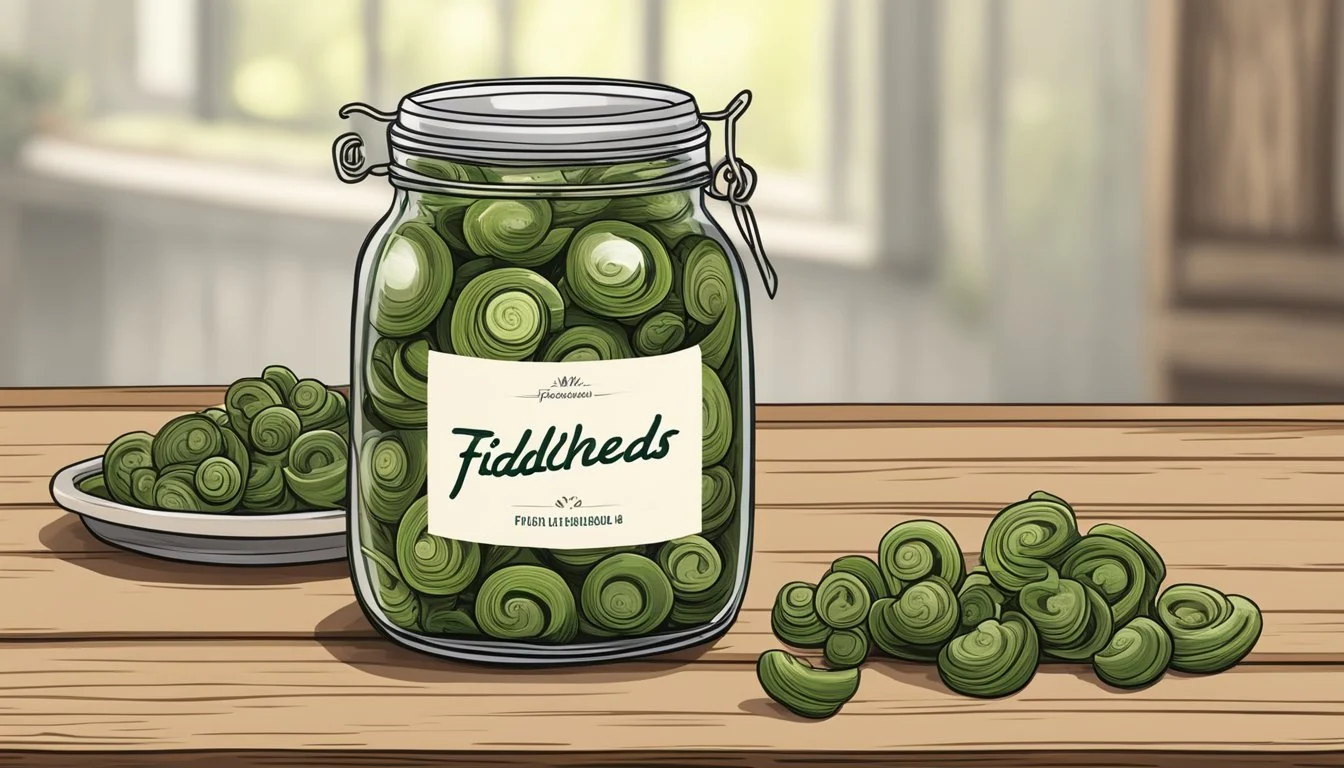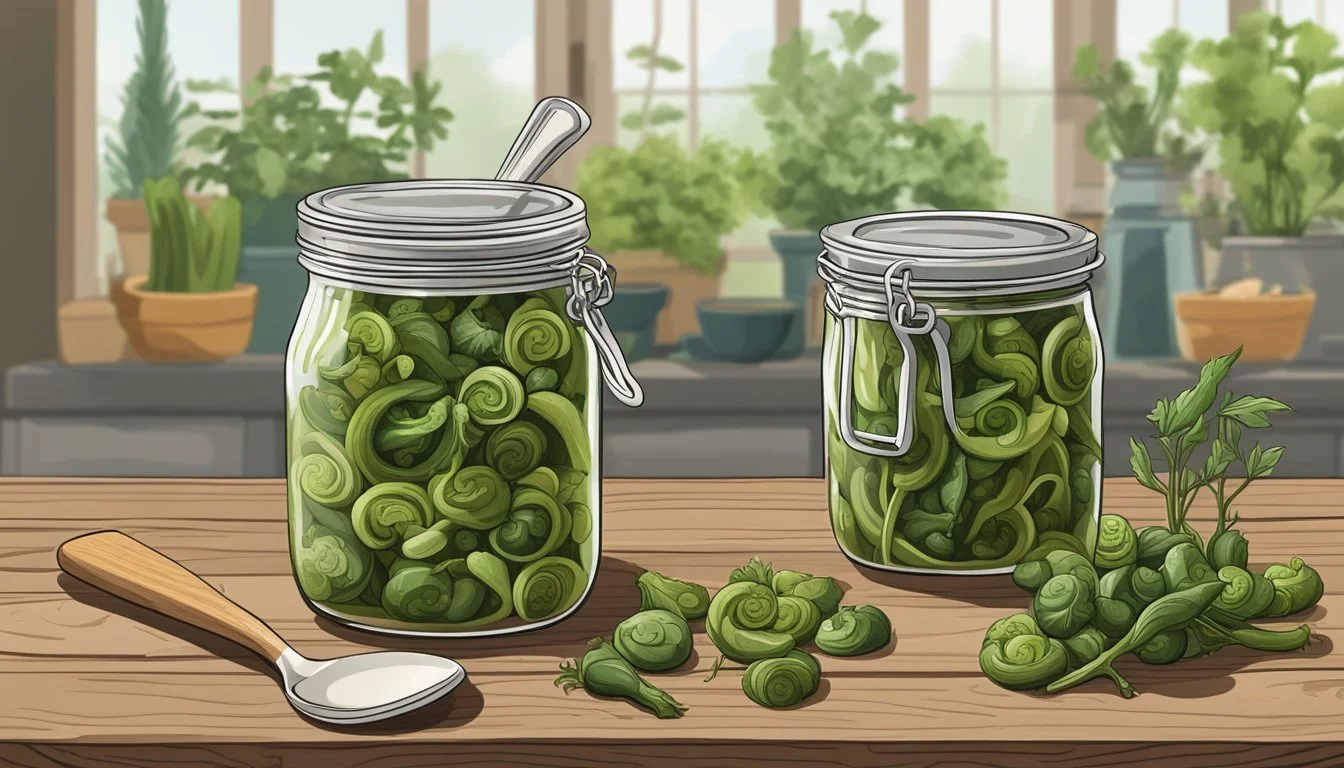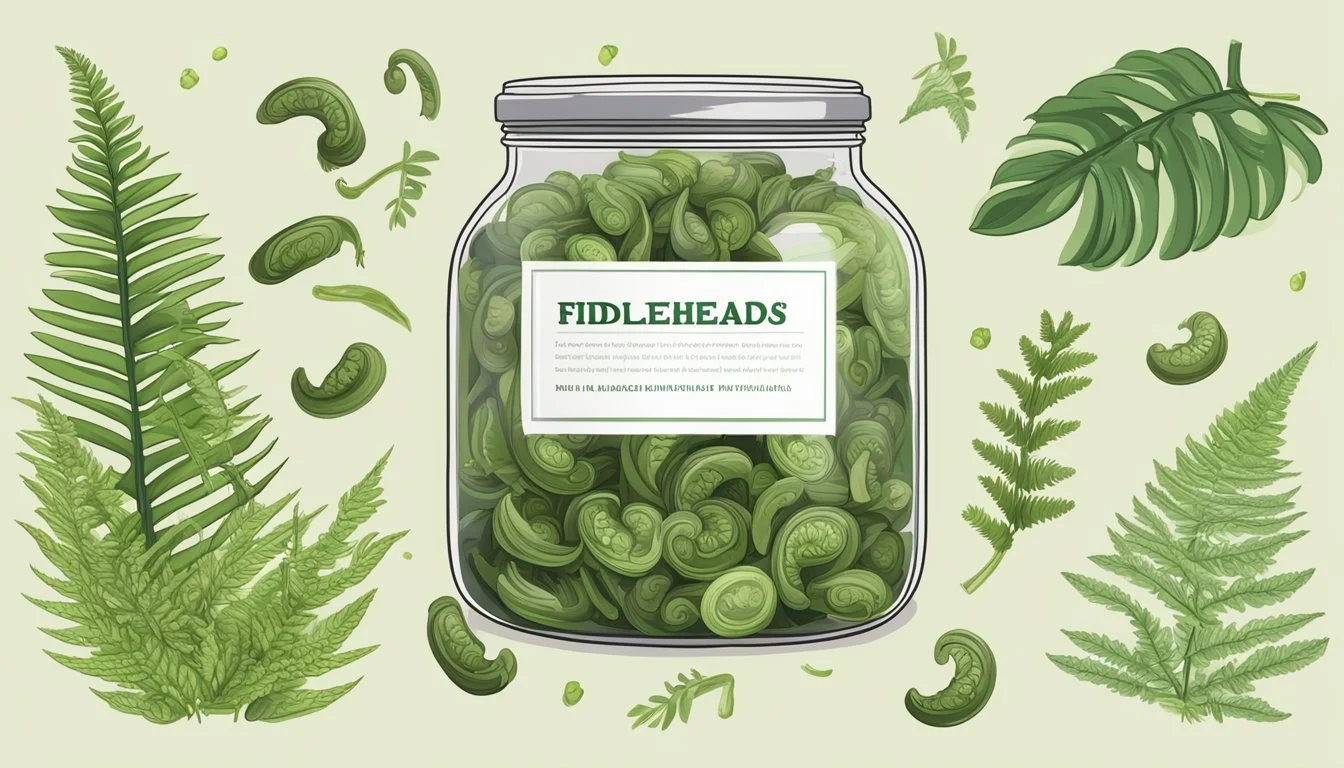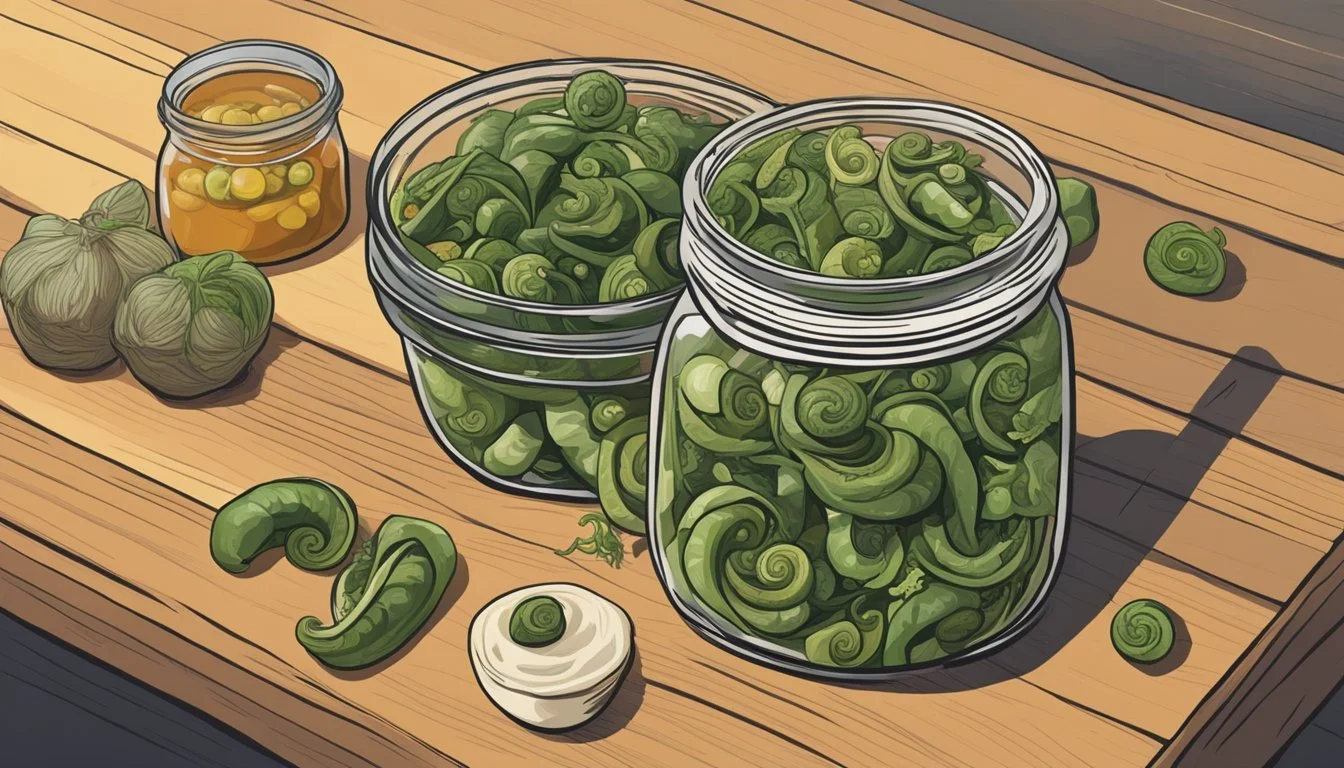Pickled Fiddleheads Substitutes
Top Alternatives to Try
Pickled fiddleheads are a seasonal delicacy cherished for their unique flavor and texture. They add a vibrant, tangy twist to various dishes. For those who can't find fresh fiddleheads, there are several excellent substitutes that can deliver similar flavor and crunch. These alternatives ensure that you can still enjoy pickled delights even when fiddleheads are out of season.
Common substitutes include pickled asparagus, which offers a similar crisp texture and tanginess. Another option is pickled green beans, known for their robust flavor and satisfying crunch. These substitutes integrate effortlessly into recipes that call for pickled fiddleheads, maintaining the desired taste and textural elements.
Experimentation with these substitutes can lead to delightful culinary discoveries. They're perfect for salads, sandwiches, or as a zesty side dish. Using these alternatives, anyone can enjoy the essence of pickled fiddleheads year-round without compromising on flavor.
Understanding Fiddleheads
Fiddleheads are the young, coiled fronds of ferns that are commonly harvested as a seasonal delicacy. They offer a unique flavor and nutritional benefits which make them a sought-after ingredient, especially in springtime recipes.
The Basics of Fiddlehead Ferns
Fiddleheads are new growths that appear at the top of a fern frond, often resembling the scroll of a violin. The most commonly consumed are ostrich fern fiddleheads, known for their slightly nutty taste and smooth texture. These edible fiddleheads are typically found in moist, shady environments in the wild. When foraging, it's important to correctly identify and only pick those that are safe to eat, as some fern species can be toxic.
Nutritional Profile
Fiddleheads are a nutritional powerhouse. They are rich in vitamins A and C, making them strong antioxidants. They also contain notable amounts of iron, potassium, and fiber. This unique combination of nutrients helps support immune function, regulate blood pressure, and promote digestive health. Furthermore, fiddleheads have omega-3 and omega-6 fatty acids, which are essential for heart health and reducing inflammation.
Forage and Harvest Guidelines
Foraging for fiddleheads usually takes place in the early spring when the ferns first emerge. It’s crucial to harvest them sustainably by only taking a few from each plant to allow the fern to continue growing. Ostrich ferns are generally preferred due to their texture and flavor. Once harvested, fiddleheads should be cleaned thoroughly to remove any dirt or grit, and cooked properly to eliminate any potential toxins. Cooking methods often include boiling or steaming prior to eating or pickling.
Preparation and Safety
Proper preparation of fiddleheads is crucial to ensure they are safe to eat and enjoyable. Key steps include cleaning and blanching the fiddleheads to remove dirt and bacteria and identifying toxic varieties to avoid potential health risks.
Cleaning and Blanching Fiddleheads
Cleaning fiddleheads thoroughly is essential before cooking or preserving. Start by placing them in a colander and rinsing under cold, running water. Remove any brown, papery husk and trim the ends.
Blanching is another critical step. Bring a large pot of water to a rolling boil and prepare an ice bath. Add small batches of fiddleheads to the boiling water and cook for 2 minutes. Remove and immediately plunge them into the ice bath to halt the cooking process.
After blanching, drain the fiddleheads well. Blanching not only mitigates risks associated with harmful microbes but also preserves the vibrant green color. It is a must before freezing fiddleheads to maintain their texture and flavor.
Identifying Toxic Varieties
When foraging or buying fiddleheads, it’s important to identify and avoid toxic varieties. Ostrich fern fiddleheads (Matteuccia struthiopteris) are the only safe fern variety for consumption. They are characterized by a smooth, deep green coil with a U-shaped groove on the inside stem.
Avoid other ferns that might be toxic or cause digestive issues. Toxic varieties can cause symptoms like vomiting, cramps, or even serious illness if consumed. Always make sure you source fiddleheads from reputable suppliers or forage with someone knowledgeable about edible ferns.
Monitoring the proper identification and preparation methods ensures fiddleheads are safe for consumption and enjoyable to eat.
Pickling Fundamentals
Pickling is a time-honored technique that combines ingredients, canning methods, and precise equipment to preserve foods through fermentation or vinegar immersion.
Introduction to Pickling
Pickling extends the shelf life of foods by using vinegar, such as cider vinegar, and salt solutions to inhibit bacterial growth.
This method enhances flavors while ensuring safe consumption over prolonged periods.
Two primary pickling types are fermentation pickling, where natural bacteria produce lactic acid, and vinegar pickling, which uses acidity from vinegar, common for quick results.
Key ingredients typically include vinegar, salt, sugar, and various spices.
Maintaining the right headspace in jars is crucial to prevent spoilage and ensure proper sealing.
Essential Pickling Equipment
Successful pickling requires specific tools:
Canning Jars/Mason Jars: These are fundamental for storing and aging pickled items. Ensure they are sterilized to prevent contamination.
Water Bath Canner/Boiling Water Bath: This equipment is necessary to process pickled jars, ensuring they are sealed correctly.
A water bath canner uses boiling water to heat jars thoroughly.
Lids and Rings: These components secure the seal on jars, preventing air from entering.
Funnels: Useful for transferring liquids into jars without spillage, maintaining cleanliness and efficiency.
Proper tool use and maintenance help achieve the best results, ensuring safety and extending the lifespan of pickled products.
Pickled Fiddleheads Recipe Guide
Pickled fiddleheads are a delightful way to preserve the unique flavors of this seasonal delicacy. Below are specific instructions and tips on how to prepare pickled fiddleheads, along with variations to tweak the basic recipe according to your taste preferences.
Basic Recipe Instructions
Blanching the fiddleheads is a crucial first step. Boil 1 quart (480 ml) of water with 1 tsp (6g) of salt in a medium saucepan. Immerse the cleaned fiddleheads and blanche for 60 seconds. Immediately drain and rinse them with ice water to halt cooking.
Prepare the brine by combining 2 cups water, 1 cup white vinegar, 1 tbsp kosher salt, and 1 tbsp white sugar in a small saucepan. Bring the mixture to a simmer, stirring until the salt and sugar dissolve.
Place the blanched fiddleheads into clean glass jars. Pour the hot brine over the fiddleheads, covering them completely. Seal the jars tightly and refrigerate. Let them pickle for at least a week to develop flavors.
Ingredient Variations
To add flavor, consider incorporating different spices and herbs. Add 1 tsp black peppercorns, 1 tsp mustard seeds, 2 garlic cloves (smashed), and 1 bay leaf to the brine. Experiment with dill, fennel seeds, allspice berries, red pepper flakes, or coriander seeds for unique twists.
For a spicy kick, add sliced ginger or white peppercorns. Sweet lovers can add more white sugar. Including aromatics like sliced shallot or mint leaves can further enhance the complexity of the flavors.
Adjust the saltiness and acidity by modifying the proportions of kosher salt and vinegar as per your preference.
Substitute Options for Pickled Fiddleheads
When pickled fiddleheads aren't available, several substitutes can capture their unique texture and flavor. These alternatives range from specific vegetables to various vinegar and seasoning options.
Vegetable Substitutes
Asparagus: A popular substitute due to its similar texture and slight bitterness. Pickled asparagus is easy to find and offers a comparable crunch to fiddleheads.
Ramps: Known for their garlic-like flavor, pickled ramps bring an aromatic quality that mimics the delicate taste of fiddleheads. They are usually available in spring, just like fiddleheads.
Pickled Garlic Scapes: These provide a similar crunch and a mild garlic flavor, making them a great stand-in. Their unique shape and texture are akin to what one might expect from pickled fiddleheads.
Cucumbers: Basic pickles can be a versatile substitute. While not identical in flavor, their tanginess and crunch offer a similar snacking experience. They are widely available and easy to prepare at home.
Vinegar and Seasoning Alternatives
Rice Wine Vinegar: For those looking to replicate the mild acidity of pickled fiddleheads, rice wine vinegar is an excellent choice. It has a subtler taste compared to other vinegars.
White Wine Vinegar: This variety adds a touch of sophistication with its fruity undertones and is less harsh than distilled vinegar.
Lemon Peel: Incorporating lemon peel into pickling solutions can introduce a citrusy zing, enhancing the flavor profile of the substitutes. It pairs well with both vegetables and vinegar.
Seasonings: Thyme, pepper, and celery seeds are commonly used in pickling recipes and can be adjusted to taste. Balancing these can approximate the intricate flavors found in pickled fiddleheads, complementing the chosen vegetable substitute effectively.
Serving and Usage Ideas
Pickled fiddleheads can be used creatively in a variety of dishes and are easy to store for future use. They add a unique, tangy flavor that can enhance many meals, from gourmet to everyday snacks.
Innovative Pairings and Dishes
Pickled fiddleheads make an excellent addition to charcuterie boards, providing a tangy contrast to meats and cheeses. Their unique flavor also adds interest to salads and sandwiches.
When used in a vinaigrette, they can bring a bright, acidic note. Toss them into a mixed green or grain salad. Incorporate them into your favorite burgers or meat dishes for a zesty twist. Garnishing toast with pickled fiddleheads and a sprinkle of thyme creates a sophisticated snack.
Preservation and Storage Tips
Proper storage ensures that pickled fiddleheads stay fresh and safe to eat. Refrigerate your pickled fiddleheads immediately after they've been prepared or opened. Store them in an airtight container with the brine covering them fully.
Freezing can extend their usability. Drain the brine, lay them flat on a baking sheet to freeze individually, and then store in freezer-safe bags. Leftover brine can be reused for marinating vegetables or making sauces.
Always check for preserved quality by ensuring the fiddleheads are submerged in brine and the container is sealed tightly.
Health Benefits and Nutritional Information
Pickled fiddleheads are not only a culinary delight but also offer several health benefits. They are packed with essential nutrients, making them a valuable addition to a balanced diet.
Health Impact of Fiddleheads
Fiddleheads are an excellent source of essential vitamins and minerals. They contain high levels of vitamin A, vitamin C, and vitamin K. Vitamin A is vital for maintaining good vision and skin health, while vitamin C strengthens the immune system.
Vitamin K plays a crucial role in bone health by aiding in bone mineralization and maintaining bone density. Fiddleheads are also rich in fiber, promoting digestive health and aiding in weight management.
Additionally, their antioxidant properties help protect cells from oxidative damage, potentially reducing the risk of chronic diseases.
Nutrition Facts for Pickled Fiddleheads
Nutrient Amount per 100g Calories ~34 Vitamin A 72% of RDA Vitamin C 34% of RDA Vitamin K Significant amount Fiber 10% of RDA Iron Notable amount Potassium Significant amount
Pickled fiddleheads retain many of the nutritional benefits of fresh fiddleheads. They are low in calories and provide a substantial amount of iron and potassium, which are crucial for blood and cardiovascular health.
The fermenting process may alter some nutrient levels but also introduces beneficial probiotics, which can further aid digestive health. This makes pickled fiddleheads a nutritious and delicious option for enhancing your diet.
Community Insights
Enthusiasts of pickled fiddleheads often contribute valuable insights and alternatives in community forums and review sections. Many praise the use of bread and butter pickles as a delightful substitute, blending sweetness and tanginess much like the original.
User Suggestions:
Pickling Techniques: Several users recommend blanching the substitute vegetables for a minute to retain their crispness. This method is popular, particularly when handling tender veggies.
Flavor Variants: Adding spices like mustard seed, celery seed, and turmeric to the brine mixture is a frequently mentioned practice. These spices mirror the complex flavors found in many traditional pickling recipes for fiddleheads.
Popular Substitutes:
Green Beans: These are often highlighted in discussions as a good alternative due to their similar texture and taste profiles when pickled.
Asparagus Tips: This substitute is favored for its delicate texture, offering a similar culinary experience to fiddleheads when preserved in a brine.
Example Recipe Adjustments: Consider the following adapted recipe based on community feedback:
Ingredient Quantity Vinegar 2 cups Sugar 1 cup Mustard Seed 1 tsp Celery Seed 1 tsp Turmeric 1 tsp Substitute Veggies 2 cups (green beans or asparagus tips)
Involving the community's insights into pickling formulas ensures that alternatives are both authentic and flavorful, reflecting collective experiences and preferences.









